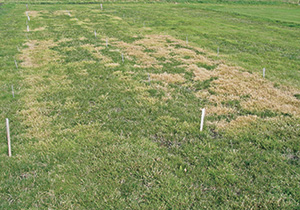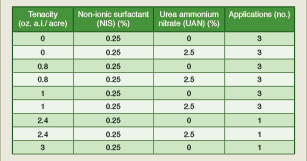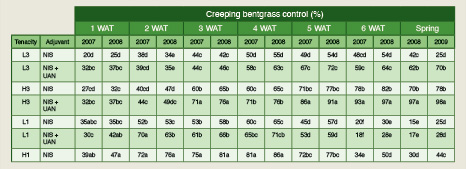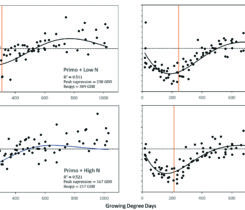Improve the efficacy of Tenacity for creeping bentgrass control
By Deying Li, Ph.D.

A view of the experimental area following treatment with Tenacity. Leaf tissue of Tenacity treated creeping bentgrass has turned brown. Photo: Deying Li
Since the launching of Tenacity (mesotrione) as a turfgrass herbicide by Syngenta in 2009, many studies have been conducted by researchers to take advantage of this unique product. One of its uses is selective control of creeping bentgrass from other cool-season grasses, such as Kentucky bluegrass and perennial ryegrass.
Creeping bentgrass on putting greens, tees or fairways often escapes to surrounding areas of a different cool-season species. The results are undesirable visual quality, poor playing conditions and scalping.
The efficacy of a foliar systemic herbicide application depends on many factors, including reaching the plant leaves, retaining herbicide on the leaf surface, penetration into the leaves, movement to the site of action, length of activity in the plants, absorption by roots, persistence in soil, and soil characteristics. Therefore, any attempts to improve the efficacy of a foliar systemic herbicide should address one or more of these basic factors (Calhoun et al., 2005).
Tenacity is a systemic pre-emergent and post-emergent herbicide for the selective contact and residual control of weeds in turfgrass. It works by inhibiting p-hydroxyphenyl pyruvate dioxygenase (HPPD), an enzyme essential for the biosynthesis of carotenoids. Without carotenoids, excessive light energy destroys chlorophyll and causes new growth to appear white before necrosis and death (Giese et al., 2005).
A careful study of the Tenacity label reveals that besides uniform application, the label addresses factors of soil moisture; leaf surface retention and penetration (addition of a non-ionic surfactant); and persistence in the plants (repeated application requirement).
Hypothesis and research objectives
This led to the hypothesis of our current study. Since the herbicide prevents the synthesis of carotenoids that protect plants from intense sunlight, if the sunlight is not intense, the herbicide would not be as effective. Dead leaves of creeping bentgrass caused by an initial Tenacity application may block light penetration to the lower canopy. Could the removal of dead creeping bentgrass leaves by raking before subsequent application of Tenacity improve the herbicide efficacy? In addition to non-ionic surfactant (NIS), could other adjuvants, such as urea ammonium nitrate (UAN), improve the herbicide absorption (Dodds et al., 2007)?
Experiment and methods
To test the hypothesis, an experiment was conducted in field plots that had an established stand of BrightStar perennial ryegrass overseeded with Penncross creeping bentgrass at the Agricultural Experiment Station, Fargo, N.D., in 2007 and repeated in 2008. The soil was a silty clay with 4.6 percent organic matter, 2 percent sand, 46 percent silt, and 52 percent clay.
Soil chemical analysis showed 68 ppm P, 320 ppm K, and pH 7.8. The grass was mowed weekly at 2.0 inches. Nitrogen was applied at 2.0 lbs. per 1,000 sq. ft. per year from polymer coated sulfur-coated urea (43N-0P-0K) in two equal applications in May and September of both years. Potassium was applied at 3.5 lbs. per 1,000 sq. ft. per year from potassium sulfate (0N-0P-41.5K) in two equal applications in May and September of both years. Irrigation was provided to prevent drought stress.

Table 1: Treatment list for creeping bentgrass control with Tenacity
at different rates, timing, and adjuvant.
The experiment was arranged in a split-plot design. Raking was the whole plot treatment and herbicide was the subplot treatment. Herbicide treatments included Tenacity at 0.8 and 1.0 oz. a.i. per acre applied singly and three times sequentially on a two-week interval with 0.25 percent (v/v) non-ionic surfactant (R-11) or 0.25 percent (v/v) non-ionic surfactant plus 2.5 percent (v/v) UAN solution that contained 28 percent N (Table 1).
The first treatment in 2007 was applied on August 17, and the first treatment in 2008 was applied on July 24. The single treatment was applied at the same time as the first application of the sequential treatments. The herbicide was applied with a backpack sprayer pressurized with carbon dioxide at 36 psi and equipped with flat-fan nozzles at 19 inches spacing held about 18 inches above the soil surface to deliver a spray volume of 10 gal. per acre.
The raking treatment was applied using a power rake set at 1.2 inches height prior to the first herbicide treatment and weekly thereafter. The clippings were manually collected and removed using a spring rake. Creeping bentgrass control was visually evaluated weekly after the first treatment based on a 0 to100 scale (Camper, 1986), where 0 equals no effect, 1 to 30 equals slight, 31 to 60 equals moderate (rating above 30 considered unacceptable injury), 61 to 99 equals severe injury and 100 equals complete death. Evaluation of creeping bentgrass survival also was conducted on May 29, 2008 and May 14, 2009.
The data for creeping bentgrass control were subjected to statistical analysis. Fisher’s protected least significant difference (LSD) was used to compare treatment means.
Results

Table 2: Effects of dead tissue removal by raking on creeping bentgrass control at different weeks after treatment with Tenacity (values averaged across different rates, timing, and adjuvant).
Removing clippings and dead leaf tissue by raking prior to herbicide application resulted in better creeping bentgrass control three to six weeks after treatment in 2007, but only at three and four weeks after treatment in 2008 (Table 2). The raking effects on creeping bentgrass control also appeared the following spring of both years (Table 3).
The differences between the two years might be attributed to the lower average temperature in 2008 than in 2007, despite the solar radiation of 16.1 MJ m-2 in 2007 vs. 22.5 MJ m-2 in 2008 during the months of study. It indicates that temperature and sunlight intensity both impact the efficacy of Tenacity. Our observation in another study also showed low efficacy of Tenacity in creeping bentgrass control under low temperature conditions.

Table 3: Creeping bentgrass control at different weeks after treatment (WAT) with Tenacity
at different rates, timing, and adjuvant with values averaged across rake treatments.
Sequential applications of 1.0 oz. per acre with UAN plus non-ionic surfactant at a two-week interval provided the highest observed creeping bentgrass control of 93 percent in 2007 and 97 percent in 2008 (Table 3). In both years, adding UAN to non-ionic surfactant improved Tenacity efficacy when applied at either low or high rates. Although other reports showed that three sequential applications of Tenacity can achieve 97 percent to 99 percent control 8 weeks after initiation of treatment (Jones and Christians, 2007), this study showed that, without raking or adding UAN to the spray solution, only 78 percent to 82 percent control was achieved.
Compared to other treatments, only three sequential applications of 1.0 oz. per acre applied at two-week intervals with both UAN and non-ionic surfactant provided complete control of creeping bentgrass in the spring evaluation one year following the field study (Table 3).
Conclusions
Tenacity at or below an annual total rate of 3 oz. per acre applied with non-ionic surfactant, whether in one application or in three sequential applications on two-week intervals, provided only moderate creeping bentgrass control under the climate and soil conditions at our experimental site. Removal of dead clippings and adding UAN to non-ionic surfactant plus Tenacity provided satisfactory creeping bentgrass control with three sequential treatments at rates of 1.0 oz. per acre. Since little dead leaf tissue will be removed by mowing following an application of Tenacity, superintendents may need to remove dead leaf tissue by raking prior to sequential Tenacity treatments in order to improve efficacy.
Based on the results of this study, Tenacity should be applied at 1.0 oz. per acre in each of three sequential applications on two-week intervals using a non-ionic surfactant plus UAN with power raking. Power raking will remove debris before each Tenacity application and allow for the greatest control of creeping bentgrass.
Deying Li, Ph.D., is an associate professor of turfgrass science in the Department of Plant Sciences at North Dakota State University. He can be reached at deying.li@ndsu.edu.
References
Calhoun, R.N., G.J. Rinehart, A.A. Hathaway, and D.D. Buhler. 2005. Maximizing cultural practices to minimize weed pressure and extend herbicide treatment interval in a cool-season turfgrass mixture. Intl. Turfgrass Soc. Res. J. 10:1184-1188.
Camper, N.D. 1986. Research methods in weed science. 3rd ed. Southern Weed Sci. Soc., Champaign, IL.
Dodds, D.M., D.B. Reynolds, J.H. Massey, M.C. Smith, and C.H. Koger. 2007. Effect of adjuvant and urea ammonium nitrate on bispyribac efficacy, absorption, and translocation in barnyardgrass (Echinochloa crus-galli). II. Absorption and translocation. Weed Science 55:406-411.
Giese, M.S., R.J.Keese, N.E. Christians, and R.E. Gaussoin. 2005. Mesotrione: A potential selective post-emergence herbicide for turf grass, p. 100-101. In: D. Thorogood (ed.). ITS Annexe-Technical Papers. Volume 10. International Turfgrass Society. Fort Lauderdale, Fla.
Jones, M.A., and N.E. Christians. 2007. Mesotrione controls creeping bentgrass (Agrostis stolonifera) in Kentucky bluegrass. Weed Technology. 21:402-405.










